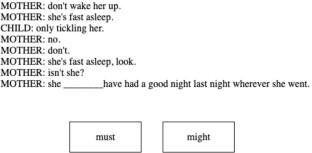Natural Language Semantics ( IF 1.524 ) Pub Date : 2022-05-19 , DOI: 10.1007/s11050-022-09196-4 Anouk Dieuleveut , Annemarie van Dooren , Ailís Cournane , Valentine Hacquard

|
This paper investigates when and how children figure out the force of modals: that possibility modals (e.g., can/might) express possibility, and necessity modals (e.g., must/have to) express necessity. Modals raise a classic subset problem: given that necessity entails possibility, what prevents learners from hypothesizing possibility meanings for necessity modals? Three solutions to such subset problems can be found in the literature: the first is for learners to rely on downward-entailing (DE) environments (Gualmini and Schwarz in J. Semant. 26(2):185–215, 2009); the second is a bias for strong (here, necessity) meanings; the third is for learners to rely on pragmatic cues stemming from the conversational context (Dieuleveut et al. in Proceedings of the 2019 Amsterdam colloqnium, pp. 111–122, 2019a; Rasin and Aravind in Nat. Lang. Semant. 29:339–375, 2020). This paper assesses the viability of each of these solutions by examining the modals used in speech to and by 2-year-old children, through a combination of corpus studies and experiments testing the guessability of modal force based on their context of use. Our results suggest that, given the way modals are used in speech to children, the first solution is not viable and the second is unnecessary. Instead, we argue that the conversational context in which modals occur is highly informative as to their force and sufficient, in principle, to sidestep the subset problem. Our child results further suggest an early mastery of possibility—but not necessity—modals and show no evidence for a necessity bias.
中文翻译:

寻找力量:儿童如何辨别可能性和必要性模态
本文研究儿童何时以及如何找出情态的力量:可能性情态(例如,可以/可能)表达可能性,以及必要性情态(例如,必须/必须) 表示必要性。模态提出了一个经典的子集问题:鉴于必要性包含可能性,是什么阻止学习者假设必要性模态的可能性含义?在文献中可以找到此类子集问题的三种解决方案:第一种是让学习者依赖向下包含 (DE) 环境(J. Semant. 26(2):185–215, 2009 中的 Gualmini 和 Schwarz);第二个是强烈的(这里是必要的)含义的偏见;第三个是让学习者依赖源自会话上下文的语用提示(Dieuleveut 等人在 Proceedings of the 2019 Amsterdam colloqnium, pp. 111–122, 2019a;Rasin 和 Aravind 在 Nat. Lang. Semant. 29:339– 375,2020)。本文通过检查 2 岁儿童和 2 岁儿童语音中使用的模态来评估每种解决方案的可行性,通过语料库研究和实验相结合,根据使用环境测试模态力的可猜测性。我们的结果表明,鉴于模态在对儿童的讲话中使用的方式,第一个解决方案是不可行的,而第二个解决方案是不必要的。相反,我们认为模态出现的会话上下文对于它们的力量来说是非常有用的,并且原则上足以回避子集问题。我们的儿童结果进一步表明早期掌握了可能性——但不是必要性——模态,并且没有证据表明存在必要性偏差。我们认为,模态出现的会话上下文对于它们的力量来说是非常有用的,并且原则上足以回避子集问题。我们的儿童结果进一步表明早期掌握了可能性——但不是必要性——模态,并且没有证据表明存在必要性偏差。我们认为,模态出现的会话上下文对于它们的力量来说是非常有用的,并且原则上足以回避子集问题。我们的儿童结果进一步表明早期掌握了可能性——但不是必要性——模态,并且没有证据表明存在必要性偏差。



























 京公网安备 11010802027423号
京公网安备 11010802027423号